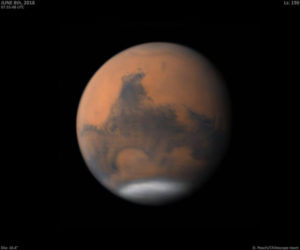
The planet Mars is one of the most interesting planets to observe with a small telescope, but also one of the most difficult. The planet only gets close enough to Earth to give up much detail just once every 780 days (about two years and two months), and when it does make an apparition, it still appears relatively small compared to Jupiter or Saturn. But observing Mars is worth the effort. It’s the only planet to reveal an appreciable amount of surface detail in a small telescope, and it also features occasional surprises such as dust storms and local fogs and cloud banks.
Seeing Mars takes a little practice, however, as well as the right tools for the job. This guide will help you understand what you can see on the surface of Mars, especially near the opposition of January 15-16, 2025. And it will help you get the best view of this remarkable world with a telescope and a few essential accessories.
The 2025 Mars Opposition
Mars is nearly always visible somewhere in the sky, except for the few week’s it’s in conjunction and lost in the Sun’s glare. However, it’s almost always too far away to reveal much detail, even in a big backyard telescope. When Mars is at its farthest point from Earth, at a distance of 225 million kilometers, the planet shines at a modest magnitude +1.8 and has a disk that’s just 3.5″ across. That’s about the same apparent size as the planet Uranus.
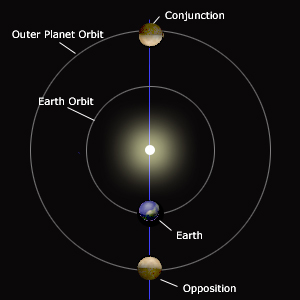
But as Earth and Mars make their way around the Sun, our planet catches up to Mars in the inside track and makes a relatively close approach. At this point, Mars appears opposite the Sun in the night sky, and astronomers say Mars is at opposition. The four to six weeks on either side of opposition is the best time to see the planet Mars in a telescope. The January 15-16, 2025 opposition isn’t as spectacular as the past few such event since Mars’ elliptical orbit means the planet lies a little further away this time. Mars will be closest to Earth on January 12, a few days before opposition, when it’s 96 million kilometers away. By comparison, at the last opposition in 2020, Mars was about 62.5 million kilometers away.
And there’s better news this year as Mars is occulted by the full Moon at opposition on January 13, a spectacular event that’s visible across much of Canada and the United States.
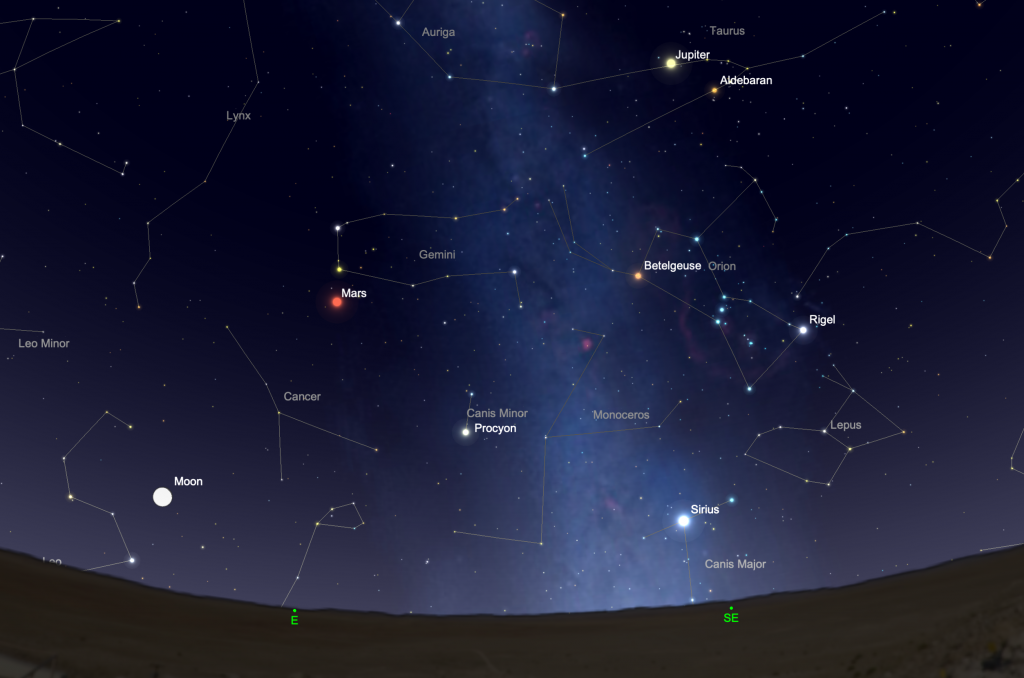
Where to Find Mars in the Night Sky
Where to see Mars? When it’s in the sky near opposition, you can’t miss it. The planet is prominent in the constellation Gemini, just north and east of the stars of Orion. Near opposition, ochre-colored Mars grows to a brightness of magnitude -1.3, much brighter than any star (except fr Siruis) and outshone only by the Moon and Jupiter, and shines with a steady ochre-colored glow. At this opposition, the planet grows to an apparent size of 14.6″ (though it’s a tiny bit larger a week earlier).
Even without a telescope, Mars is great fun to observe. The planet’s red-orange color is a consequence of iron-oxide in its surface sands; it was this color prompted classical astronomers to name the planet after the Roman god of war. If you’re so inclined, you can watch the motion of the solar system in action as Mars moves slightly eastward from night to night relative to the background stars, then grows stationary for a time around December 6, 2024 then starts moving westward against the background stars for the rest of the year. You can also track the increasing brightness of Mars on the way to opposition on January 15-16 as well as its slow fade in brightness through the rest of the year. By the end of February, the planet will fade to magnitude -0.3 and shrink to an apparent diameter of 10.9″. It begins is prograde (eastward) motion on February 24, 2025.
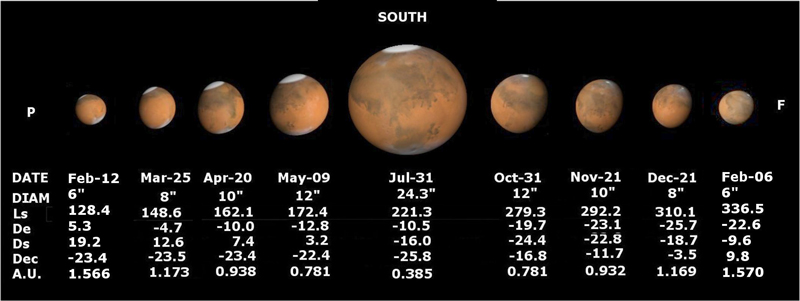
Telescopes, Eyepieces, and Filters for Observing Mars
Binoculars make Mars brighter and may resolve its tiny disk. But if you want to see any surface detail, you are going to need a telescope. Nearly any telescope is better than none. On a night of good seeing near opposition, even a small telescope with 60mm to 80mm aperture will show the largest and most prominent features on the Martian surface, although the image will be small and the resolution too low to reveal much detail.
If you want a larger and clearer image of Mars for visual viewing or imaging, consider a telescope with as long a focal length and as large an aperture as you can afford and physically transport and handle. Longer focal lengths give larger images, while larger aperture gives better resolution of fine detail. Schmidt-Cassegrain and Maksutov-Cassegrain telescopes are a great choice for planetary observers and imagers. These scopes pack long focal lengths into a small optical tube, and larger apertures of 6″, 8″, 9.25″ or more also offer higher resolution for revealing fine detail in good seeing conditions. Larger apertures also give brighter images at high magnification than smaller-aperture scopes.
Which eyepieces are best for observing Mars? Nearly any good eyepieces will do, especially those that will give you a medium and high magnification. The highest usable magnification depends on the seeing conditions and the aperture of your telescope. Generally, a magnification of 30-50x the aperture (in inches) works well on nights of average-to-good seeing. For example, if you have a 4-inch telescope, try 120x to 200x. If you have an 8″ scope, try 240x to 400x. Again, experiment to get the best view each night. And you don’t need a fancy super-wide-field eyepiece to get a good view of Mars (or other planets). Good Plossl eyepieces, for example, do the job nicely as do their many modern variations.

With so many features on the surface of Mars and in the planet’s atmosphere, serious observers should consider one or two color filters to help extract maximum detail. These filters come in metal cells that thread into the back of an eyepiece. Many standard color filters also help with observing the features on the Martian surface and in the atmosphere. Here are some suggested color filters for Mars observing sessions (in order of usefulness):
- Red (#23A, #25, #29) gives maximum contrast of surface features, enhances fine surface details, dust clouds boundaries, and polar cap boundaries.
- Blue (#80A, #82A, #38A) and deep blue (#47) shows atmospheric clouds, discrete white clouds, and limb hazes, equatorial cloud bands, polar cloud hoods, and darkens reddish features
- Light Green (#56) darkens red and blue features, enhances frost patches, surface fogs, and polar caps
- Orange (#21 or #23A) increases contrast between light and dark features and penetrates hazes and most clouds.
- Yellow (#12, #15) can brighten desert regions and darkens bluish and brownish features.
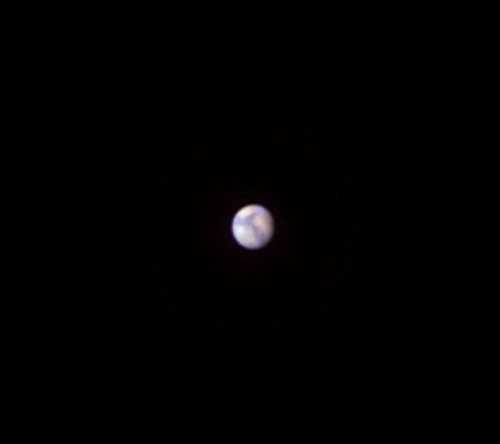
What to See on Mars
OK, you’ve got the tools to observe Mars. Now what can you see? Under ideal conditions, quite a bit. But Mars is a much more challenging target than Jupiter and Saturn. These two gas giants are resplendent with features in their colorful atmospheres, and Saturn’s rings are dazzling even for beginning observers. The features on the surface of Mars are smaller and require a sharp eye and very steady sky. Sorting out which feature is which, however, can be a little tricky.
Backyard telescopic observers will see three types of regions on Mars: one or both polar caps, the lighter red-orange regions covered with rusty dust, and the darker regions which are large areas of exposed volcanic rock. The rotation of the planet and the occasional unexpected dust storm on Mars bring these features in and out of view each night, which is partly what makes Mars so interesting to observe.
During early days of telescopic observation, the light regions on Mars were thought to be continents, so they were given names that described land masses. Major regions of this type include Elysium Planitia (the Elysium Plain), Arabia Terra (Land of Arabia), the circular Hellas Planitia (Plains of Greece), and Amazonis Planitia (Amazon Plains).
The darker regions were named after seas, lakes or other watery features. There’s the very large Mare Erythraeum (Arabian Sea) in the south, Mare Acidalium (named after a legendary fountain) in the north, and most strikingly, the large wedge-shaped feature Syrtis Major named after the Gulf of Sidra off the coast of Libya. Many of these dark regions appeared to early telescopic observers to change size during the Martian year. They suspected this was caused by changes in vegetation or rainfall. It turns out the dark regions do not change their dimensions, but are instead occasionally obscured by atmospheric dust.

The Martian polar caps are also striking features that wax and wane with the Martian seasons. Most of each cap consists of a layer of carbon dioxide frozen out of the atmosphere. The northern polar cap has a layer of frozen carbon dioxide just 1 meter thick, while the southern polar cap has a layer about 8 meters thick. Underneath these layers is a base of water ice about 2 km to 3 km thick.
In a small telescope, only the largest features of the Martian surface are visible. The trick, especially for beginners, is sorting out which feature is which. The map above from Sky and Telescope magazine shows the most prominent non-polar regions of the planet projected onto a disk for a range of longitudes. In this image south is up, so if you are using optics that do not invert the image, you must make mental accommodation for this map.
The key features to look for on Mars include:
- The arrow-shaped dark region of Syrtis Major (see above image at 290º)
- The southern dark features including Mare Tyrrhenum (at 225º), Mare Erythraeum (at 45º), and Mare Sirenum; also look for the circular reddish-orange feature Hellas (at 315º in the image above)
- The broad ochre regions of rusty sand marked by Arabia and Eden Terra, Tharsis and Arcadia, Amazonis, and Elysium, all of which are at equatorial and temperate latitudes
- In the north of Mars, look for the dark areas of Utopia Planitia (at 270º)
and Mare Acidalium (at 45º) - And of course look for the polar caps. At a glance, you will immediately see which polar cap is most easily visible. In 2014, the north polar cap is tilted towards Earth, and since it’s summer in the northern hemisphere of Mars, the cap is small and slowly shrinking
Because of the rotation period of Mars, the view of the planet changes slightly from night to night. Mars rotates in the same direction as Earth every 24 hours and 37 minutes, just a little longer than the rotation period of Earth. If you observe Mars with a correct view with north up and east to the left, the planet will appear to move from left to right such that features on the surface will appear to move out of view 37 minutes earlier each night. The overall effect makes it appear Mars makes a full backward revolution in 40 days.
The Mars profiler from Sky and Telescope is a very useful tool to help you find out which surface features are visible each night. You can access the tool at the link below.
https://skyandtelescope.org/observing/interactive-sky-watching-tools/mars-which-side-is-visible/
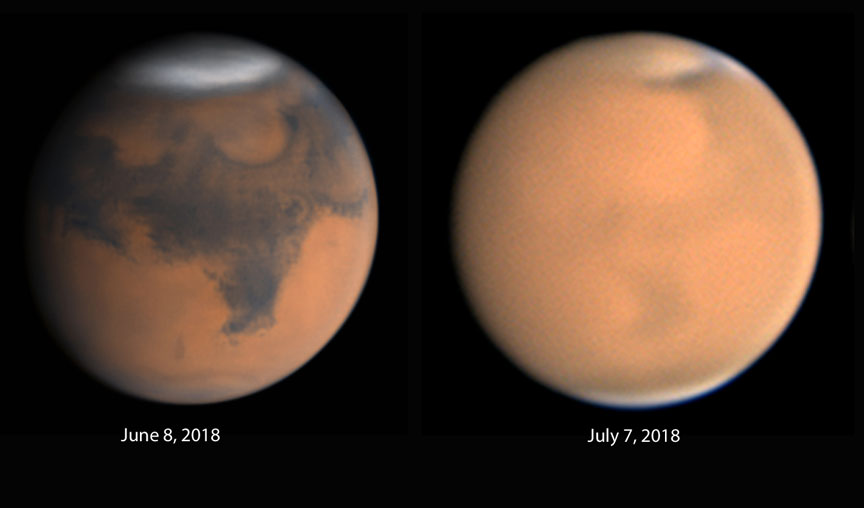
How to Get the Best View – A Final Few Tips
Observing Mars through a telescope is like playing a musical instrument. It’s a learned skill that takes continual practice. Even experienced observers need to practice their observing skills and learn to see the planet anew at each apparition. This ochre world is notoriously small and hard to observe visually, but it rewards the patient stargazer with sights unseen elsewhere in the solar system. It’s worth the effort.
Some key tips for observing the Red Planet:
- Observe near opposition. As mentioned earlier, Mars is only large enough to reveal detail about three or four weeks before and after opposition when it’s closest to Earth.
- Pick a Night with Steady Air. Seeing is critical when observing Mars. Pick a night when the air is steady and the stars aren’t twinkling too much. Sometimes, nights with a little haze have steadier air than crystal-clear nights. On a night of bad seeing, Mars is a boiling orange blob. On a night of excellent seeing, it’s a little world.
- Acclimatize Your Telescope. Bring your scope out at least 30-60 minutes before you plan to observe. By cooling it down to the ambient temperature, you’ll prevent air currents inside your scope from degrading the image of the planet. Scopes with large mirrors or lenses, and those with closed tubes, take longer to acclimate than smaller telescopes and those with open tubes.
- Observe Frequently. Because Mars rotates every 24 hours and 37 minutes, you’ll see almost the same face of the planet at the same time each night for several nights in a row. So extend your observing session over several hours on one night, or at the same time over four to six weeks to see both sides of the planet.
That’s it. Go see Mars for yourself, and observe every clear night you can. With some patience and good luck, you will see details on the only planet in the solar system that reveals its surface to us Earthbound observers.
Share This: